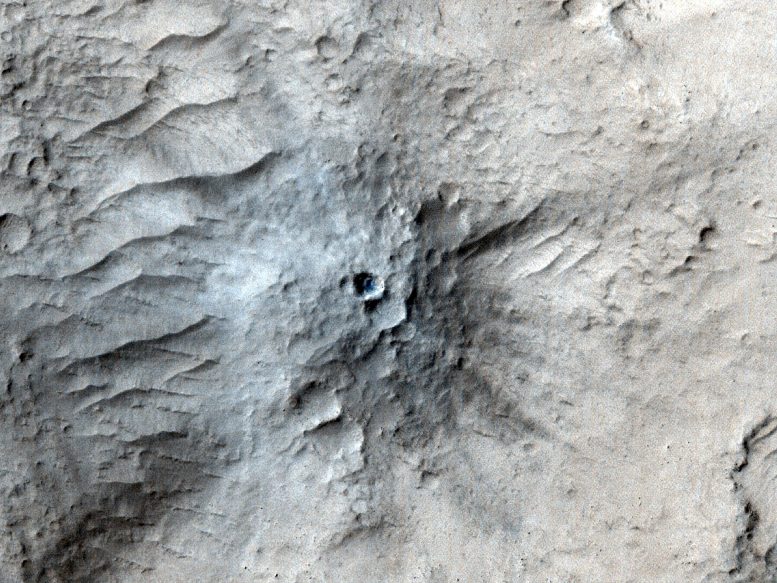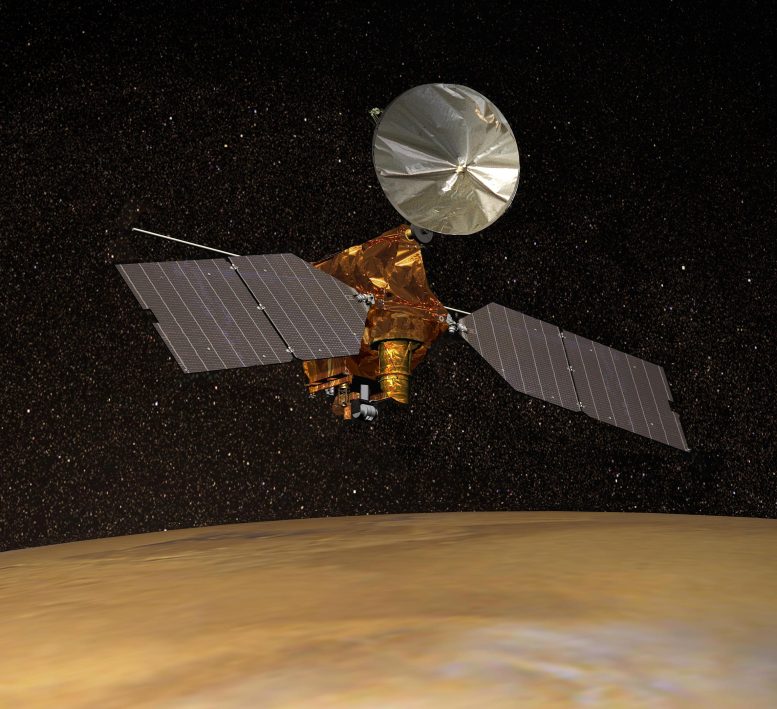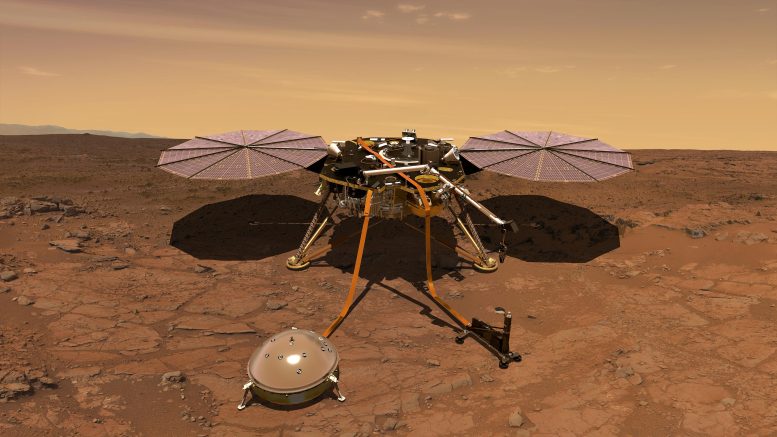
New research shows that meteoroid impacts on Mars generate seismic signals that travel much deeper than previously thought, revealing unexpected properties of the planet’s interior.
By comparing marsquake data from NASA’s InSight lander with impact craters identified by the Mars Reconnaissance Orbiter, scientists discovered that some impacts create a “seismic highway” through the mantle, rather than being dampened by the crust. This breakthrough challenges previous models of Mars’ interior and could refine our understanding of rocky planets, including Earth.
Meteoroids Reveal Mars’ Deep Secrets
Meteoroids crashing into Mars create seismic waves that travel deeper into the planet than previously thought. This discovery comes from two new studies that compare marsquake data recorded by NASA’s InSight lander with impact craters identified by the Mars Reconnaissance Orbiter (MRO).
Published on February 3 in Geophysical Research Letters, these studies show that even after NASA retired InSight in 2022, its data continues to provide valuable insights. InSight was the first mission to place a seismometer on Mars, detecting over 1,300 marsquakes. These quakes originate either from deep underground as rocks crack under heat and pressure or from meteoroid impacts on the surface.
Tracing Seismic Waves Through Mars
By analyzing how seismic waves travel through Mars’ crust, mantle, and core, scientists can better understand the planet’s interior structure. This research not only sheds light on Mars but also helps explain how rocky planets like Earth and the Moon evolved.
Researchers have in the past taken images of new impact craters and found seismic data that matches the date and location of the craters’ formation. But the two new studies represent the first time a fresh impact has been correlated with shaking detected in Cerberus Fossae, an especially quake-prone region of Mars that is 1,019 miles (1,640 kilometers) from InSight.

A Crater That Defies Expectations
The impact crater is 71 feet (21.5 meters) in diameter and much farther from InSight than scientists expected, based on the quake’s seismic energy. The Martian crust has unique properties thought to dampen seismic waves produced by impacts, and researchers’ analysis of the Cerberus Fossae impact led them to conclude that the waves it produced took a more direct route through the planet’s mantle.
InSight’s team will now have to reassess their models of the composition and structure of Mars’ interior to explain how impact-generated seismic signals can go that deep.
“We used to think the energy detected from the vast majority of seismic events was stuck traveling within the Martian crust,” said InSight team member Constantinos Charalambous of Imperial College London. “This finding shows a deeper, faster path — call it a seismic highway — through the mantle, allowing quakes to reach more distant regions of the planet.”

Spotting Mars Craters With MRO
A machine learning algorithm developed at NASA’s Jet Propulsion Laboratory (JPL) in Southern California to detect meteoroid impacts on Mars played a key role in discovering the Cerberus Fossae crater. In a matter of hours, the artificial intelligence tool can sift through tens of thousands of black-and-white images captured by MRO’s Context Camera, detecting the blast zones around craters. The tool selects candidate images for examination by scientists practiced at telling which subtle colorations on Mars deserve more detailed imaging by MRO’s High-Resolution Imaging Science Experiment (HiRISE) camera.
“Done manually, this would be years of work,” said InSight team member Valentin Bickel of the University of Bern in Switzerland. “Using this tool, we went from tens of thousands of images to just a handful in a matter of days. It’s not quite as good as a human, but it’s super fast.”
Bickel and his colleagues searched for craters within roughly 1,864 miles (3,000 kilometers) of InSight’s location, hoping to find some that formed while the lander’s seismometer was recording. By comparing before-and-after images from the Context Camera over a range of time, they found 123 fresh craters to cross-reference with InSight’s data; 49 of those were potential matches with quakes detected by the lander’s seismometer. Charalambous and other seismologists filtered that pool further to identify the 71-foot Cerberus Fossae impact crater.

Refining Marsquake Detection
The more scientists study InSight’s data, the better they become at distinguishing signals originating inside the planet from those caused by meteoroid strikes. The impact found in Cerberus Fossae will help them further refine how they tell these signals apart.
“We thought Cerberus Fossae produced lots of high-frequency seismic signals associated with internally generated quakes, but this suggests some of the activity does not originate there and could actually be from impacts instead,” Charalambous said.
AI’s Expanding Role in Planetary Science
The findings also highlight how researchers are harnessing AI to improve planetary science by making better use of all the data gathered by NASA and ESA (European Space Agency) missions. In addition to studying Martian craters, Bickel has used AI to search for landslides, dust devils, and seasonal dark features that appear on steep slopes, called slope streaks or recurring slope linae. AI tools have been used to find craters and landslides on Earth’s Moon as well.
“Now we have so many images from the Moon and Mars that the struggle is to process and analyze the data,” Bickel said. “We’ve finally arrived in the big data era of planetary science.”
References:
“New Impacts on Mars: Systematic Identification and Association With InSight Seismic Events” by V. T. Bickel, I. J. Daubar, G. Zenhäusern, G. Doran, C. Charalambous, B. Fernando, A. Sokolowska, K. L. Wagstaff, T. Pike, S. C. Stähler, J. Clinton and D. Giardini, 3 February 2025, Geophysical Research Letters.
DOI: 10.1029/2024GL109133
“New Impacts on Mars: Unraveling Seismic Propagation Paths Through a Cerberus Fossae Impact Detection” by Constantinos Charalambous, W. Thomas Pike, Benjamin Fernando, Natalia Wójcicka, Doyeon Kim, Marouchka Froment, Philippe Lognonné, Savana Woodley, Lujendra Ojha, Valentin T. Bickel, Joseph McNeil, Gareth S. Collins, Ingrid J. Daubar, Anna Horleston and Bruce Banerdt, 3 February 2025, Geophysical Research Letters.
DOI: 10.1029/2024GL110159
More About InSight
NASA’s Jet Propulsion Laboratory (JPL) managed the InSight mission for the agency’s Science Mission Directorate. InSight was part of NASA’s Discovery Program, which is overseen by the Marshall Space Flight Center in Huntsville, Alabama. Lockheed Martin Space in Denver built the spacecraft, including its cruise stage and lander, and provided operational support throughout the mission.
Several European partners played key roles in InSight’s success. France’s Centre National d’Études Spatiales (CNES) provided the Seismic Experiment for Interior Structure (SEIS) instrument, with leadership from the Institut de Physique du Globe de Paris (IPGP). Additional contributions to SEIS came from IPGP, Germany’s Max Planck Institute for Solar System Research (MPS), Switzerland’s ETH Zurich, Imperial College London, Oxford University, and JPL. The German Aerospace Center (DLR) supplied the Heat Flow and Physical Properties Package (HP3), with contributions from the Space Research Center (CBK) of the Polish Academy of Sciences and Astronika in Poland. Spain’s Centro de Astrobiología (CAB) provided the mission’s temperature and wind sensors.
JPL, a division of Caltech in Pasadena, California, also manages the Mars Reconnaissance Orbiter (MRO) for NASA’s Science Mission Directorate in Washington. The University of Arizona operates MRO’s High-Resolution Imaging Science Experiment (HiRISE), which was built by BAE Systems in Boulder, Colorado. The Context Camera, designed and operated by Malin Space Science Systems in San Diego, also plays a key role in capturing detailed images of Mars’ surface.
Never miss a breakthrough: Join the SciTechDaily newsletter.
1 Comment
“Damp” is used to describe the reduction of vibrations, while “dampen” is used to describe the act of making something wet.
For example, consider the spring dampening effect of El Niño.